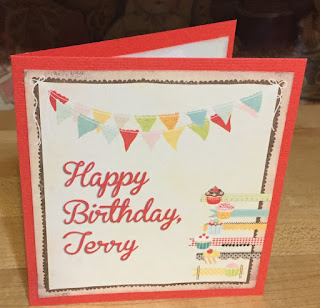I'm sharing today this darling vintage sewing machine that I made for my sis-in-law. She's a quilter and had shared a different cardstock sewing machine that was posted on a quilting site. It was cute, but I remember seeing one that had a more vintage look. I went online and came upon a photo of a darling sewing machine posted, by coincidence, by a good crafty friend of mine, Misty (her blog is: cardsbygeyda.com, January, 2017 post).
The cut file for this sewing machine is from Cre8iveCutz.com. Of course, I had to put a couple of my own ideas into it. Firstly, I decided I wanted the box and extension to be really strong, so I made it in chipboard. And, added a real metal (So cute. I think it's Tim Holtz) drawer handle as well.
I have to admit, I made a huge mistake making the basic bones of the box. I had to throw it away, as I glued too fast and too many prongs at the same time. Word to the wise: Take your time and glue only two prongs at a time! It made all of the difference.
Thankfully, I hadn't put on any of the overlays on it yet, so only had to cut the basic machine, the inside part of the wheel and the spool holder.
One more note here: Having made this and experienced a massive fail the first time, I would suggest a small change in the pattern. It will be most helpful if you add a score line parallel to the bottom front fold line/score line. So, you will have two parallel lines on the bottom piece going from front to back on either side of the square hole that the needle comes through. The line would be .6525" from the front bottom score line, as shown in the following photo. It's very difficult to turn that corner without a score line. So, whether you score it by hand prior to applying the bottom to the front and back of the sewing machine, or you add a score line into your cut file (which is what I did), it will be quite helpful in putting it together.
I found an image of an old J.&P. Coats thread spool, and altered it to use at the top of the spool using print-2-cut with my Sizzix Eclips 2. The spindle that holds the spool was open at the top, so I added a piece to close it off.
Here's the drawer open. The chipboard makes it so strong and substantial, and I'm so glad I went that route.
To make it a bit stronger, I made overlays for the top of the
machine and the bottom, so they are two layers thick of cardstock. And just a note, the wheel on the right side of the sewing machine spins around freely.
I used a gold metallic cardstock for the needle guide and the head of the machine. I embossed it, and put some alcohol inks on to antique it a bit.
And, that's about it! Thank you, Misty, for answering all of my questions and for the support! You are the best!
Thanks for taking a browse. I enjoyed the process and the outcome so very much!
Be Sew Happy!





















